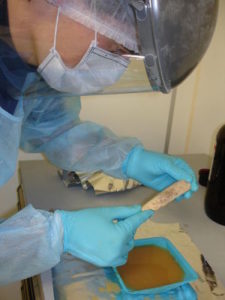
It is almost common knowledge now, thanks to recent DNA studies, that many non-African humans living today have traces of Neanderthal DNA within their genomes — the evidence, according to geneticists, that anatomically modern humans (Homo sapiens) interbred with their contemporary Neanderthal species cousins tens of thousands of years ago in places where they coexisted in present-day Europe and Asia.
Now, a new study, conducted by researchers under the leadership of Benjamin Vernot and Joshua Akey of the University of Washington, Seattle, have come up with a proven methodology to determine the percentages and precise genome segments that have been inherited, and which parts of the total Neanderthal genome sequence is observed to have bestowed an adaptive advantage (and thus retained) in their modern human descendants.
Their model involved a two-staged computational strategy framework, without additonal sampling of fossil remains, applied to whole-genome sequences of 379 Europeans and 286 East Asians, courtesy of data from the 1000 Genomes Project. The results of their research suggested that, while the total amount of Neanderthal sequence in any individual modern human is relatively low, about 2 – 4 percent, the cumulative amount of the Neanderthal genome identified across all humans in the aggregate represents segments that constituted about 20 percent of a total Neanderthal genome sequence.
In some parts of the modern genome, they observed large regions without Neanderthal DNA, suggesting that certain portions of the archaic genetic sequence were deleterious to survival. On the other hand, they also observed sections of the modern sequence that showed more Neanderthal DNA than expected. Vernot and Akey concluded that these sequences remained because their functions provided an adaptive advantage, perhaps related to skin phenotype.
Their study could have far-reaching implications for further research.
“Our results provide a new avenue for paleogenomics studies,” write Vernot and Akey in their report, “allowing substantial amounts of population-level DNA sequence information to be obtained from extinct groups even in the absence of fossilized remains……. potentially allowing the discovery and characterization of previously unknown hominins that interbred with modern humans.”*
In a related study published in the Jan. 29 issue of the journal Nature, another team of scientists led by Harvard Medical School geneticist David Reich, including Svante Pääbo of the Max Planck Institute for Evolutionary Anthropology in Germany, has obtained results suggesting that modern human populations have inherited other genetic traits from Neanderthals that are connected to both positive adaptive functions and characteristics and those that could be described as negative. They have found traces of Neanderthal DNA, for example, that have affected the keratin filaments in the skin — proteins that make hair, nails and skin tougher for surviving colder climates — genes that affect the immune system; and genes that affect such conditions as Crohn’s disease, type 2 diabetes, smoking behavior, billiary cirrhosis, and lupus. The researchers did this by analyzing the genetic variants found in 846 non-African people and 176 people from sub-Saharan Africa, and then comparing the results to that of a 50,000-year-old Neanderthal with a relatively intact genome sequence.
Details of the Vernot and Akey study are published in the journal Science, and on January 29, 2014 in Sciencexpress.
_________________________
Cover Photo, Top Left: Working in a clean room, researchers at the Max Planck Institute for Evolutionary Anthropology in Leipzig, Germany, took extensive precautions to avoid contaminating Neanderthal DNA samples – extracted from bones like this one – with DNA from any other source, including modern humans. NHGRI researchers are part of the international team that sequenced the genome of the Neanderthal, Homo neanderthalensis. Wikimedia Commons
*Article #16: “Resurrecting Surviving Neanderthal Lineages from Modern Human Genomes,” by B. Vernot; J.M. Akey at University of Washington in Seattle, WA.
_______________________________________________________________________________________________________________________
Read about the most fascinating discoveries with a premium subscription to Popular Archaeology Magazine. Find out what Popular Archaeology Magazine is all about. AND MORE:
 On the go? Purchase the mobile version of the current issue of Popular Archaeology Magazine here for only $2.99.
On the go? Purchase the mobile version of the current issue of Popular Archaeology Magazine here for only $2.99.
And, Popular Archaeology’s annual Discovery edition is a selection of the best stories published in Popular Archaeology Magazine in past issues, with an emphasis on some of the most significant, groundbreaking, or fascinating discoveries in the fields of archaeology and paleoanthropology and related fields. At least some of the articles have been updated or revised specifically for the Discovery edition. We can confidently say that there is no other single issue of an archaeology-related magazine, paper print or online, that contains as much major feature article content as this one. The latest issue, volume 2, has just been released. Go to the Discovery edition page for more information.
Subscription Price: A very affordable $5.75 for those who are not already premium subscribers of Popular Archaeology Magazine (It is FREE for premium subscribers to Popular Archaeology). Premium subscribers should email [email protected] and request the special coupon code. Or, for the e-Book version, it can be purchased for only $3.99 at Amazon.com.





